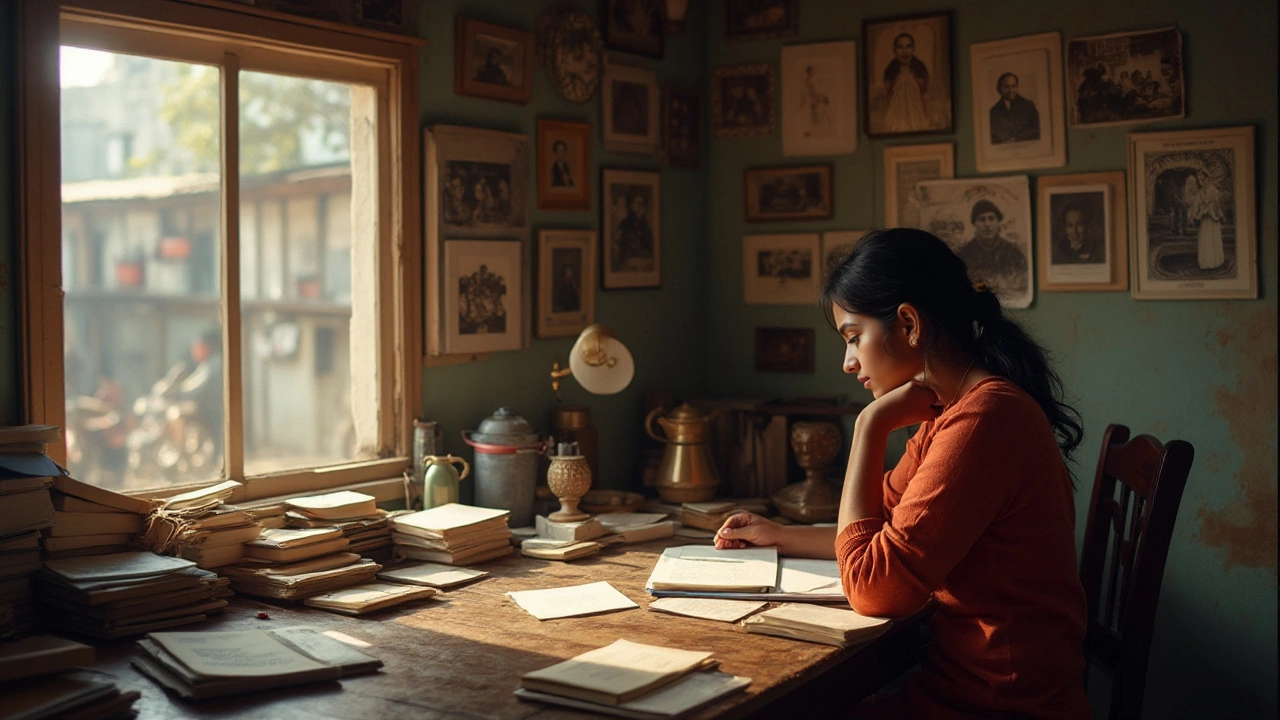The villanelle is a fascinating form of poetry known for its specific structure and repeating refrains. Originating from the pastoral songs of Italy and evolving into the complex form we recognize today, it has captured the imaginations of poets across cultures, including those in India.
With its 19-line format consisting of five tercets and a quatrain, the villanelle offers both a challenge and a creative outlet for poets. The form requires a thoughtful balance between rigidity and expression, making it a favorite for those who appreciate the melding of formality and artistic freedom.
Origins and History
The villanelle poetry is a delightful and intricate form that traces its roots back to the rustic life of medieval Italy. Originally, the term 'villanelle' referred to songs that depicted pastoral themes, sung by villagers—and it is from these humble origins that the poetic structure gained its name. While the form we recognize today took shape much later, its essence has remained tied to the simplicity and rhythm of early life. It wasn't until the 16th century in France that the villanelle began to evolve into the structured poetic form we are familiar with now.
The transformation of the villanelle from a simple song to a sophisticated poem is largely credited to the French poet Jean Passerat. He wrote what is considered one of the earliest examples of a modern villanelle, "J'ay perdu ma Tourterelle," which set the standard for the repeating refrain pattern. This poem exemplifies the characteristic repeated lines that grace villanelles. Over time, this became the blueprint, with poets around the world inspired to experiment with this unique form.
In exploring the historical progression of the villanelle, it’s clear that its spread outside of France contributed greatly to its evolution. By the late 19th and early 20th centuries, the form had begun to gain popularity in English-language poetry. This was significantly influenced by the works of poets like W. H. Auden and Elizabeth Bishop. As the form took root in English-speaking countries, it began to garner interest even in diverse places like India, where poets were beginning to explore Western forms more deeply alongside traditional Indian compositions.
"The villanelle delights poets for the way it lays bare the mechanics of repetition, reinforcing the ephemeral yet everlasting nature of poetic thought." - William EmpsonAs the literary circles of India embraced global influences, the villanelle became a medium through which Indian poets could fuse classical Indian thematic essence with European forms. The meeting of these traditions demonstrated a cultural exchange that enriched both the poetry of the East and the West. Today, the villanelle continues to be appreciated for its unique structure that invites both discipline and innovation, making it a cherished form in various literary landscapes across India.
To understand the villanelle’s journey is to appreciate a tapestry of cultural interactions where each strand brings historical richness. It bears testament to poetry's ability to transcend borders and find a home within different creative minds, thus perpetuating its charm and challenges amongst Indian poets and enthusiasts around the globe.

Structure and Form
The villanelle's structural allure lies in its strict rhyme scheme and repetitive refrains, weaving a poetic tapestry that is both intricate and harmonious. This form consists of 19 lines, divided into five tercets—three-line stanzas—followed by a closing quatrain, which is a four-line stanza. This delicate arrangement is not for the faint-hearted, as it demands a skillful blend of repetition and creativity. The rhyme scheme utilized is A-B-A for each of the tercets, concluding with a more complex A-B-A-A for the quatrain. Within this tightly-knit structure, the first and third lines of the opening tercet serve as alternating refrains, appearing again at the end of the subsequent tercets and finally reuniting in the closing couplet.
One of the fascinating aspects of the villanelle poetry is how its structure challenges poets to explore themes deeply through its refrains. By repeating lines, poets are given a unique opportunity to refine and adjust the meaning or tone of these lines with each appearance, creating a powerful sense of progression and meditative reflection. Villanelle's mid-Hollywood moment was brought upon by the Dylan Thomas classic "Do Not Go Gentle into That Good Night," where insistence is masterfully achieved through the poem's cyclical nature.
"The structure allows poets to show reverberations and nuances in their themes, akin to the echoes of life,” notes renowned poet John Paul."The pull between repetition and alteration makes the villanelle a dance within constraints, enabling poets to transform a single theme into a lyrical narrative.
The form demands meticulous attention to language and rhythm, pushing both emerging and seasoned poets out of their comfort zones. In India, this poetic form resonates with many who find the tight disciplinary nature akin to the ancient structural forms native to the subcontinent. As Indian poetry forms continue to evolve and embrace global influences, integrating a traditional yet universally challenging structure like the villanelle breathes novel energy into modern creations. Aspiring poets are often advised to choose words that lend themselves to the musicality of the poem—consonance, assonance, and alliteration can enhance the repeated lines and rivet the attention of readers. As the villanelle bridges profound narrative simplicity with complexity, it becomes a favored ground for experimenting with emotional depth and philosophical contemplation. With its fixed form acting like a support, poets can let their thematic explorations wander freely, yet harmoniously return to the poem's central refrains.

Famous Villanelle Examples
The villanelle as a poetic form has produced some of the finest pieces in English literature, known for their emotional depth and lyrical beauty. One of the most celebrated villanelles is Dylan Thomas's 'Do Not Go Gentle into That Good Night.' This poem is widely hailed for its urgent tone and profound exploration of struggling against death. Through its repeated refrains, 'rage, rage against the dying of the light,' the poem encapsulates a universal struggle that resonates with readers across generations. Thomas's mastery over the structure serves as a testament to how the format can be manipulated to convey intense emotion.
Another remarkable villanelle comes from Elizabeth Bishop, whose poem 'One Art' subtly weaves together themes of loss and acceptance. The poem's exploratory tone offers readers a sense of understanding losses through its engaging refrains. Bishop ingeniously uses the repetitive structure to add layers to the narrative, inviting readers to reflect on their experiences with loss. This poem's poignant simplicity is a significant factor in its lasting influence, demonstrating the villanelle's power in encapsulating life's dualities.
Bishop and Thomas are among the many poets who have thrived within the confines of this rigorous poetic structure. Margaret Atwood's 'You Fit Into Me' is another example of how the villanelle can be used to surprising effect. The two lines 'You fit into me / Like a hook into an eye' are contrasted with the stark imagery, highlighting how structure can foster creativity. Atwood, known for her imaginative prowess, uses the villanelle to amplify the tension and ambiguity, leaving a lasting impression on the reader.
'The villanelle is an intricate form, combining the best elements of melody and repetition, akin to a song played on a loop but with new meanings emerging each time.' - Poetry Foundation
In Indian poetry, English poets like Ranjit Hoskote have experimented with the format, blending local themes into their villanelles. These works resonate particularly with Indian audiences by reflecting regional feelings, thoughts, and settings within the poetry's intricate framework. Villanelles by Indian poets often incorporate cultural motifs, weaving tradition into the form while retaining its original essence, a beautiful confluence of global structure and local commentary.
This proliferation of the villanelle form beyond its Western origins and into different cultures demonstrates its universality and versatility. The structure allows poets from diverse backgrounds to employ its unique rhythm and refrains while adapting it to suit their thematic purposes. Whether through spectral imagery, exploration of mortality, or societal commentary, famous villanelles continue to captivate and challenge readers and writers alike, proving that this poetic form, though strict, is a wellspring of creativity.

Tips for Writing Villanelles
Embracing the art of villanelle poetry requires patience and a keen understanding of its structured form. The first step in penning a villanelle is to decide on the refrain, which consists of two lines that will be repeated throughout the poem. These refrains are like the heartbeats of the poem, providing rhythm and continuity. Choose lines that resonate on their own, yet can blend seamlessly into different contexts as the poem unfolds. It's essential to craft these lines with care, ensuring they carry enough weight to anchor the rest of the piece.
Once your refrains are set, the next step is to understand the unique stanzaic pattern of a villanelle: five tercets followed by a quatrain. The alternating rhyme scheme provides a framework that challenges poets to weave in the refrains effectively. Focusing on the rhyme can initially feel restrictive, but it offers an opportunity for creativity in finding words that fit into the natural flow of the poem. Many poets find that the constraints of the poetic structure force them to think outside the box and discover innovative ways to express their ideas.
"The villanelle’s repetitive form allows for an emotional momentum and musicality that is both challenging and thrilling," says renowned poet Mark Strand.
Writing a successful villanelle often involves revisiting and revising your work multiple times. With each iteration, delve deeper into the themes and emotions, allowing the lyrical nature of the form to amplify the message. It's helpful to keep a thesaurus handy to explore alternative word choices that fit the rhyme scheme while maintaining the intended meaning. Don't rush the process; take time to savor the journey, letting the poem evolve naturally as you work on it over days or even weeks.
Collaboration and sharing your work with others can be invaluable. Joining poetry workshops or connecting with fellow poets can provide fresh perspectives and constructive feedback. Indian poets, in particular, bring their cultural tapestry into the creation of villanelles, producing rich and diverse expressions. Sharing your villanelle with an audience not only refines your craft but also introduces you to new ideas and influences that can inspire your future writings. Remember, the beauty of a villanelle lies in its ability to harmonize the rigidity of its form with the poet's personal voice, and with each attempt, you'll gain more proficiency in achieving this balance.
